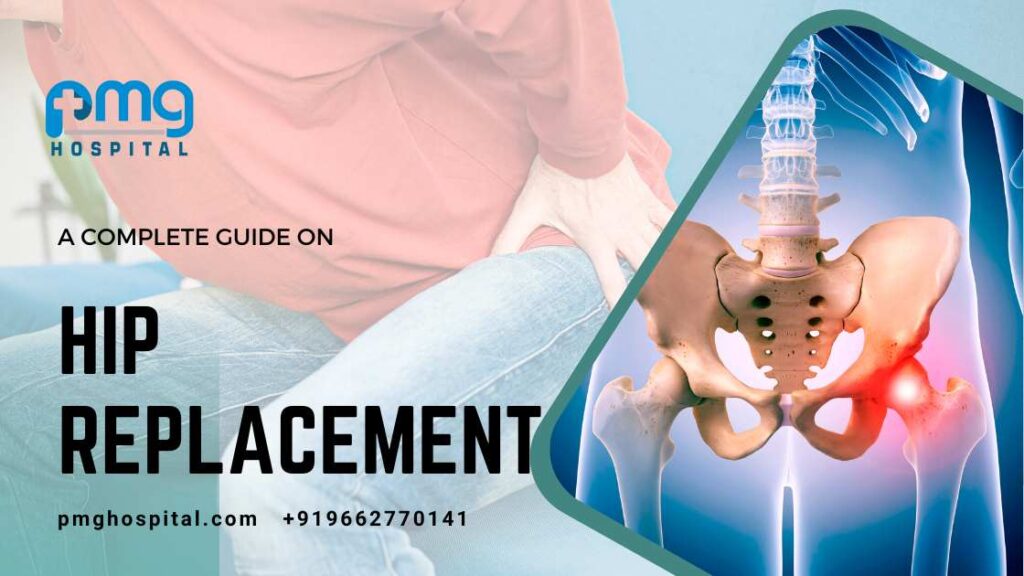Hip joints are not only an important but crucial part of our musculoskeletal system. Before we start to discuss the details of Hip replacement surgery, let’s get familiar with Hips and the types of hip arthroplasty.
Hip Anatomy
The hip is one of the largest joints in the body. A ball-and-socket joint is used to define the hip structure. The acetabulum, a part of the pelvis bone, forms the socket. The ball is the femoral head, the femur’s upper end.
The ball and socket bone surfaces are covered with articular cartilage, a smooth tissue that cushions the ends of the bones and allows them to move freely.
The hip joint is surrounded by a thin tissue called the synovial membrane. This membrane produces a small amount of fluid that lubricates the cartilage and eliminates almost all friction during hip movement in a healthy hip. Ligaments are bands of tissue that connect the ball to the socket and provide stability to the joint.
What Precisely Is A Hip Replacement Or Hip Arthroplasty?
The replacement of the hip joint with an artificial one made of metal, ceramic, or another surgical-grade material is a hip replacement. Hip replacement surgery is frequently recommended for patients with;
- Hip arthritis or severe hip joint wear causes pain, stiffness, and lack of mobility.
- Hip pain that restricts daily activities such as walking or bending
- Hip stiffness that makes it difficult to move or lift the leg
- Insufficient pain relief from anti-inflammatory medications, physical therapy, or walking aids
Hip replacement surgery is one of the most successful procedures in medical history. Joint replacement surgical techniques and technology have greatly improved the efficiency of total hip replacement since the early 1960s.
Whether you are just starting to look into treatment options for hip replacement in Ahmedabad or have already decided to have a hip replacement, this information will help you understand the advantages and disadvantages of hip replacement operations. As you already have an idea on;
- How a normal hip functions
- The root cause of hip pain
- What to expect from a hip replacement surgery?
- What exercises and activities will help you regain mobility and strength and return to normal activities?
Let’s dive further into the topic to know more about hip replacement surgery.
Surgical Techniques For Hip Replacement Surgery:
Surgical techniques such as the Posterior and Anterior approaches are there. When you are considering or have been advised to have a hip replacement, your surgeon will review the various options with you and explain why they recommend a particular approach.
Posterior Approach
The posterior approach is the most commonly used for total hip replacement.
- While the patient is lying on their side, an incision is made on the side of the hip.
- The surgeon goes through the muscles and separates some of them from the hip joint.
- It preserves the muscle to the best of its ability and will later reattach the tendons to the bone.
- Because of the success rates and ease of surgery, the posterior approach has been used successfully for hip replacements.
- More recovery time is required.
Anterior Approach
The tendons and muscles are moved out of the way during this type of surgery, resulting in no muscle damage.
- The muscles flop back into place, and only a few stitches are needed to close the small incision, improving the cosmetic appearance.
• As a result, less pain and a shorter recovery time are possible following the procedure.
• Compared to traditional hip replacements, this Anterior Approach hip replacement allows for a much faster recovery.
Types Of Hip Replacement Surgery:
There are three major types of hip replacement, out of which total hip replacement surgery is the most common and also called total hip arthroplasty. Artificial implants replace worn-out or damaged hip sections during this surgery. The socket is replaced with a strong plastic cup that may or may not have a titanium metal shell. Your femoral head will be replaced with a ceramic or metal alloy ball attached to a metal stem inserted into your femur’s top.
The other two are hip resurfacing and partial hip replacement. Hip resurfacing of the femoral head and socket is typically performed on younger, more active patients.
Partial hip replacement, also known as hemiarthroplasty, involves replacing only one side of the hip joint – the femoral head – rather than both sides, as is the case with total hip replacement. This procedure is most commonly performed on elderly patients with hip fractures.
The Aftermaths Of Hip Replacement Surgery:
Preparations Before Doing A Hip Arthroplasty
Patients can improve their recovery time and outcomes by taking certain precautions before and after surgery. You must follow the instructions and advice of your orthopedic surgeon, medical team, and rehabilitation therapist.Recovery Time
Generally, within 24 hours of surgery, your rehabilitation will begin. Within a day or two of surgery, most hip replacement patients can walk with a cane, walker, or crutches. Full recovery can take anywhere from two to eight weeks, depending on the patient’s general health and other factors.Summing Up:
Hip replacement surgery has become less complicated in recent decades. The original type of hip replacement should have no bearing on the complexity of the revision surgery. Furthermore, rebuilding a failed or worn-out hip replacement has become a much simpler procedure as technology advances. When looking for an orthopedic surgeon to perform your hip replacement surgery, research and investigate the surgeon’s credentials, experience, expertise, and track record. It is also critical to research the hospital or facility where you will have your surgery.Why PMG Hospital Is Best For Hip Replacement In Ahmedabad?
PMG hospital pertains to world-class treatment methods and infrastructures for all types of Orthopedic surgeries in Ahmedabad. Hip replacement surgery is designed to relieve pain and return you to your favorite activities. However, not all hospitals accomplish the same outcomes. Some are more trustworthy than others. With the assistance of the PMG Hospital, you can ensure that you are in safe hands.
Some of the key facilities you will get at PMG Hospital for Hip Replacement Surgery in Ahmedabad.
- Modern modular class-100 operating room
- Ultrasonic cleaner and fully automated autoclave to reduce the risk of infection during surgery
- For speedier reporting and treatments, in-house X-ray, Echo, ECG, and specialists
- ICU center for post-operative critical care
- Accommodation and meals for hospitalized patients in sharing, superior, and suite rooms
- For the convenience of the patients, an internal pharmacy
- Nurses with experience in care and treatment around-the-clock
Our motto is ‘Put Patient First‘, and with our personalized care and treatments we are the top orthopedic hospital in Ahmedabad, Gujarat. We are sure that your search for Hip Replacement/Hip Arthroplasty in Ahmedabad would end here.
Feel free to visit us or call us on +91 9662 770141



